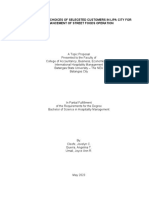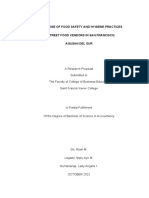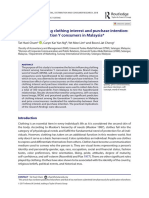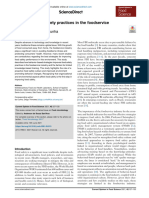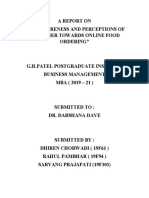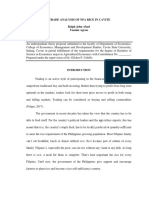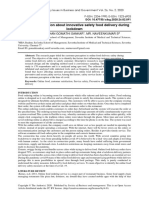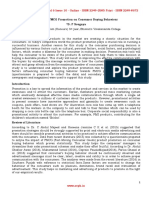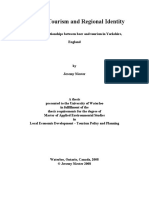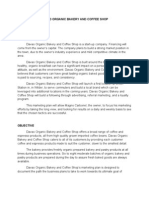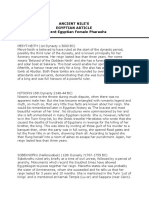Consumer Perception and Preference of Fast Food: A Study of Tertiary Students in Ghana
Consumer Perception and Preference of Fast Food: A Study of Tertiary Students in Ghana
Uploaded by
Bella Monica MontecinoCopyright:
Available Formats
Consumer Perception and Preference of Fast Food: A Study of Tertiary Students in Ghana
Consumer Perception and Preference of Fast Food: A Study of Tertiary Students in Ghana
Uploaded by
Bella Monica MontecinoCopyright
Available Formats
Share this document
Did you find this document useful?
Is this content inappropriate?
Copyright:
Available Formats
Consumer Perception and Preference of Fast Food: A Study of Tertiary Students in Ghana
Consumer Perception and Preference of Fast Food: A Study of Tertiary Students in Ghana
Uploaded by
Bella Monica MontecinoCopyright:
Available Formats
Science Journal of Business and Management
2015; 3(1): 43-49
Published online February 9, 2015 (http://www.sciencepublishinggroup.com/j/sjbm)
doi: 10.11648/j.sjbm.20150301.16
ISSN: 2331-0626 (Print); ISSN: 2331-0634 (Online)
Consumer Perception and Preference of Fast Food: A
Study of Tertiary Students in Ghana
Horsu Emmanuel Nondzor, Yeboah Solomon Tawiah
School of Business and Management Studies, Department of Marketing, Cape Coast Polytechnic Institute, Cape Coast, Ghana
Email address:
rtchorsu8@yahoo.com (E. N. Horsu), soloty2002@gmail.com (S. T. Yeboah)
To cite this article:
Horsu Emmanuel Nondzor, Yeboah Solomon Tawiah. Consumer Perception and Prefernce of Fast Food: A Study of Tertiary Students in
Ghana. Science Journal of Business and Management. Vol. 3, No. 1, 2015, pp. 43-49. doi: 10.11648/j.sjbm.20150301.16
Abstract: The study explored the perceptions, preferences and factors contributing to the growth of fast food among tertiary
students. To meet these objectives, a sample size of 159 consumers was taken from the two leading tertiary institutions in Cape
Coast; University of Cape Coast and Cape Coast Polytechnic. Pretested semi-structured questionnaires were administered to
the respondents and the data were analyzed using SPSS version 20. The results were presented using descriptive statistics
(frequencies, percentages, mean and standard deviations, tables and charts). Findings from the study indicated that the growth
of fast food is perceived to be as a result of urbanization, people working for long hours, growing interest in exotic meals,
advertising, availability of commercial buildings and rise in income. Those who do not patronize fast food perceive them to be
unhealthy, expensive and too foreign. Those who patronize however perceive them to be convenient, time saving, delicious,
good for fun and change, and expose them to likable environments. To place an order for fast food, consumers prefer them in
the form of both take-away and eat in services. The most preferred menu happened to be the exotic ones (i.e. Pizza, burger,
rice etc). The findings proved to be more significant and revealing as they will help marketers to analyze the behavioral
characteristics of consumers with respect to the consumption of fast foods.
Keywords: Fast Food, Consumer, Consumer Behaviour, Perception and Preference
1. Introduction
1.1. Introduction and Background
Rapid urbanization coupled with busy lifestyle and
advancement in technology has greatly changed the way of
life of many people including people in the developing
countries. The effects of these changes have altered the
tradition of cooking and eating at home. People are now
more reliant on ready-to-eat meals offered by businesses for
their daily sustenance and popular among them are fast foods.
Fast food is the general term used for limited menu of
foods that lend themselves to production-line techniques;
suppliers tend to specialize in products such as hamburgers,
pizzas, chicken or sandwiches [1]. First popularized in the
1950s in United States, it typically refers to food sold in
restaurant or store with preheated or precooked ingredients,
and served to the customer in a package form for take-out or
take-away [2]. The concept has spread beyond the US to
other regions of the world contributing to a global fast food
market worth of USD 477.1 billion which is expected to
reach USD 617.6 billion in 2019[3].
The most obvious advantage of fast foods are, they are
convenient, quick to serve, readily available alternative to
home food and quite affordable [4]. Consumers patronize fast
food to save time, satisfy their hunger, for pleasure and for
social interactions [5]. Before the advent of fast food, people
needed to buy a lot of ingredients from the market to prepare
food to serve to the family on time. To many people, fast
foods conveniently replace such activity as life is
increasingly becoming too busy and hectic.
Whiles convenient and economical for modern day
lifestyle, fast foods have some disturbing disadvantages.
They are typically high in calories, fat, saturated fat and salt
which have been pointed out as the major cause of heart
disease in human, diabetes and obesity [4, 8]. Such research
findings has led to critics of fast food calling for consumers
to abandon its patronage[6] resulting in a number of fast food
chains changing or introducing healthy meals to their menu.
Also because fast food concept relies on speed, uniformity
and low cost, they are often made with ingredients
formulated to achieve certain flavor or consistency and to
preserve freshness. This requires a high degree of food
engineering, the use of additives and processing techniques
44
Horsu Emmanuel Nondzor and Yeboah Solomon Tawiah: Consumer Perception and Prefernce of Fast Food:
A Study of Tertiary Students in Ghana
that substantially alter the food from its original form and
reduces its nutritional value [7].
Fast food businesses have been growing in popularity in
Ghana in the past decades. Run by both local entrepreneurs
and foreign multinational firms, they serve the Ghanaian
consumer with variety of exotic dishes including pizza,
hamburgers, fried chicken, French fries etc. Their operations
are more formal and are generally located in buildings on the
high streets or buzzing areas of cities and gas stations. There is
however a paucity of national data and literature on consumer
perceptions and preferences of fast food consumption in the
country. This paper therefore sought to fill the research gap by
exploring the influencing factors, perception and preference of
fast food consumers in the Ghanaian society with particular
emphasis on students in tertiary education.
1.2. Empirical Review of Consumer Behavior and
Perception towards Fast Food
A study of fast food perception conducted by [9],
compared a survey data of college students from Spain and
the United State. Findings from the study indicated that
consumer perceptions about fast food are cultural and gender
specific. More American college males (61%) considered
value (amount of food for the money) to be a priority than
did other respondents (35%) and relatively few American
college males (29%) cited nutritional status as important
(versus 60% of other college respondents). Convenience of
fast food is more important to Americans (69%) than
Spaniards (48%) while more Spanish college students (49%)
than Americans (18%) objected to the proliferation of fast
food establishments in their own countries.
[4] conducted an exploratory study on consumer
perception about fast food in India to estimate the importance
of various factors affecting the choice of fast food outlets by
young consumers. Results from the study indicated that
young Indian consumers have passion for visiting fast food
outlets for fun and change but home food is their first choice.
They feel homemade food is much better than food served at
fast food outlets. They have the highest value for taste and
quality (nutritional values) followed by ambience and
hygiene. Further, consumers felt that fast food outlets must
provide additional information on nutritional values and
hygiene conditions inside kitchen.
[10] in a study sought to explore the differences in fast
food preferences, perceptions and patronage between Indians
living in high-and low-income neighborhoods. Findings from
the study revealed that participant from high-income
neighborhoods were more likely to perceive western-style
fast food as fast food, while people from the low-income
neighborhoods were more likely to identify food sold by
street vendors as fast food. Also the findings revealed that
participant from both low-income and high-income
neighborhoods visited fast food restaurants for the same
reasons as convenience, price, social enjoyment and quality
meals. Both groups preferred home meals over restaurant
meals and recognized that home cooked food were healthier.
[11] conducted a research on consumer perception of food
franchise. The objective was to seek consumers perception
about two fast food franchises, McDonalds and KFC. The
research concluded that consumers attached great importance
to factors such as quality of food, facility layout, service
quality- speed and cleanliness. Taste and quality of food
items were however the most important factors that influence
consumers.
2. Method
2.1. Study Design, Area and Period
A cross-sectional study was undertaken from May to
November, 2014 among students of University of Cape Coast
(UCC) and Cape Coast Polytechnic (CCP) in Ghana. The two
institutions studied are leading institutions among many in
the country as far as tertiary education is concerned. They
however share quite different academic units. UCC runs
more faculties than CCP with programs ranging from
diploma to doctoral degrees whiles CCP runs diploma and
degree programs.
2.2. Study Population, Sampling and Data Collection
The study population consists of all the mainstream
tertiary students of Cape Coast. Students study under access,
distant learning, sandwich and evening school were excluded
from the study due to difference in characteristics in terms
program and lifestyle.
Sample size of one hundred and fifty nine (159) students
from the population was used through a pretested structured
questionnaire. The study instruments were both primary and
secondary data. The students were stratified into various
academic levels and self-administered questionnaires to them
randomly. The data gathered were analyzed using descriptive
statistics and results presented in tables, percentages and charts.
3. Results
3.1. Demographic Characteristics of Respondents
Figure 1 shows the demographic characteristics of the
respondents. Out of the 159 respondents, 95 (59.7%) were
males and 64 (40.3%) were females. 119 (74.8 %) were
between the ages of 18-25 years, 27 (17%) were between the
ages 26-35 years, 11 (6.9%) were between 36-40 years and 2
(1.3%) were 40 years or above. Majority of the respondents
62 (38.4%) were level 200 students, 38 (23.9%) were level
300 students, 33(20.8%) level 100 students, 17 (10.7%) level
400 students and 10 (6.3%) were graduate students. The
average income or pocket money of the respondents was
between GHC101-GHC500 per month.
3.2. Patronage Patterns of Fast food
3.2.1. Definition, Usage, Like or Dislike and Reasons for
not Buying
Figure 2 depicts that 114 (71.1%) of respondent defined
fast food as food sold by restaurant chains and 39 (24.5%) as
Science Journal of Business and Management 2015; 3(1): 43-49
food sold by street vendor. 135 (84.9%) of respondents have
tried fast food before whiles 24 (15.1%) have not. Out of the
135 who have tried fast food before, 117 (86.7%) liked it and
18 (13.3%) disliked it. Respondent reasons for disliking or
not trying fast food were that, fast foods were unhealthy,
expensive, too foreign and other just like home food.
3.2.2. Frequency of Fast Food Patronage and the Time
Visit to Fast Food Outlets
Figure 3 shows the frequency of fast food patronage and
the time of the day respondents usually visit fast food outlets.
The results indicates that majority of respondents 121 (76%)
patronized fast foods once a while and 103 (64.8%) usually
visits at lunch time.
Figure 1. Demographic Characteristics of Respondents.
Source: Survey Data, 2014
Figure 2. Fast food definition, usage, like or dislike and Reasons for not buying.
Source: Survey Data, 2014
45
46
Horsu Emmanuel Nondzor and Yeboah Solomon Tawiah: Consumer Perception and Prefernce of Fast Food:
A Study of Tertiary Students in Ghana
Figure 3. Meal type and Frequency of Patronage.
Source: Survey Data, 2014
3.2.3. Reasons for Patronizing Fast Food
Table 1 represents the mean score of consumers reasons
for patronizing fast food on a five point Likert scale. Some of
the reasons include; it saves time, convenient, for a change
and fun, offers variety of menu, and delicious among others.
Table 1. Consumers reasons for patronizing fast food.
Saves time
Convenient
For Change and Fun
Variety of Menu
Delicious
Like the Environment
Inexpensive (Price)
Location of Outlets
N
159
159
159
159
159
159
159
159
Minimum
1.00
1.00
1.00
1.00
1.00
1.00
1.00
1.00
Maximum
5.00
5.00
5.00
5.00
5.00
5.00
4.00
5.00
Mean
4.0818
3.8742
3.6981
3.4969
3.4780
3.0566
2.8176
2.4780
Std. Deviation
.89279
.95296
1.03578
1.07252
1.18448
1.18666
.96689
1.10142
Source: Survey Data, 2014
3.3. Perceived Popularity of Fast Food and its Contributing
Factors
Table 2a reports the mean score of fast food popularity as
perceived by respondents. Perceived factors contributing to
the growing popularity includes urbanization, long working
hours, growing interest in exotic food, advertising,
availability of commercial buildings and rise in income with
corresponding mean scores reported in Table 2b on a five
point Likert scale.
Table 2a. Perceived Popularity of Fast Food.
Fast food has become popular among Ghanaians
Minimum
Maximum
Mean
Std. Deviation
159
1.00
5.00
3.8302
.80511
Source: Survey Data, 2014
Table 2b. Perceived factors contributing to Fast Food Popularity.
Urbanization
Long Working Hours
Growing Interest in Exotic Meals
Advertisement
Availability of Commercial Buildings
Rise In Income
Source: Survey Data, 2014
N
159
159
159
159
159
159
Minimum
1.00
1.00
1.00
1.00
1.00
1.00
Maximum
5.00
5.00
5.00
5.00
5.00
5.00
Mean
4.2704
4.1321
3.6478
3.5472
3.3270
3.2013
Std. Deviation
.86189
.92170
1.01967
.97888
1.07029
1.12385
Science Journal of Business and Management 2015; 3(1): 43-49
47
of fast food on a five point Likert scale.
3.4. Consumers Perception of Fast Food
Table 3 depicts the mean scores of respondents perception
Table 3. Consumers Perceptions on Fast Foods.
Key
Home food is better than fast food
Fast food consumption causes Obesity and heart diseases
Fast food is a form entertainment
Fast foods usually have clean environments
Fast foods usually offer healthy meals
N
159
159
159
159
159
Minimum
1.00
1.00
1.00
1.00
1.00
Maximum
5.00
5.00
5.00
5.00
5.00
Mean
4.5157
3.6730
3.3899
3.3836
2.8931
Std. Deviation
.90606
1.15011
1.16332
.99873
.97819
Source: Survey Data, 2014
3.5.Consumer Preference of Fast Food
Figure 4 depicts consumers preference for fast food. On
preferred eating service, the results indicates that 76 (47.8%)
of respondents prefer Take Away meals, 15 (9.4%) prefer
Eat In meals and 68 (42.8%) prefer both Take Away and
Eat In. The types of food preferred by respondent are as
follows; exotic meals 88(55.4%) local meals 15(9.4%) and
both exotic and local meals 56 (35.2%).
Local meals preferred by consumers are as follows; rice
meals 68 (443%), Grilled Fish 57(36%), Grilled meat 38
(24%) and Fries 34 (21%). Preferred exotic meals of
consumers are as follows; Pizza 142(89%), Hamburger 114
(72%), Rice meals 98 (62%), Noodles 90 (57%), French fries
73 (46%), Hot dogs 61 (38%) and Salads 31 (19%).
Figure 4. Fast food preference of consumers.
Source: Survey Data, 2014
4. Discussion and Conclusion
4.1. Discussion
In the course of our survey, we sought to explore the
perceived growth of fast food in Ghana and its contributing
factors, consumer perceptions and preferences. The survey
focused on tertiary students in the Cape Coast Metropolis.
The results indicated that most consumers of fast food were
between the ages of 18 and 25 years (Figure 1), with male
(59.7%) patronizing it more than female (40.3%).
Consumers knowledge on fast food was measured by
asking the question, Which of the following statements most
closely match your understanding of fast food? Options
respondents could choose from were food sold by street
vendors, such as kenkey (maize meal) and fish, wakye
(rice and beans), food sold at restaurant chains such as
Sizzler, and no answer. In [9] research on differences in
perceptions and fast food eating behaviours between Indians
living in high- and low-income neighborhoods of Chandigarh,
48
Horsu Emmanuel Nondzor and Yeboah Solomon Tawiah: Consumer Perception and Prefernce of Fast Food:
A Study of Tertiary Students in Ghana
India, respondents from high-income neighborhood were
more likely to report fast food as food sold at restaurant
chains. In contrast, respondents from low-income
neighborhoods were more likely to report fast food as food
sold by street vendors. In this present paper however,
majority of the respondents (71.1%) reported fast food as
food sold by restaurant chains, with 24.5% reporting fast
food as food sold by street vendors [Figure 2]. This finding
confirms the perceived definition of fast food as given by
Indians living in high-income neighborhoods of Chandigarh.
[Figure 2] continues to reveal that 84.9% of respondents
have tried fast food before. Out of the 84.9% who have tried
fast food, 86.7% liked it and continues to patronize it.
Reasons for other respondents who have not tried fast food
before (15.1%) or have tried but disliked it (13.3%) were that,
fast foods were unhealthy, expensive, and too foreign and
others just like home food.
Whiles the study indicated a high patronage of fast food
among tertiary students, Figure 3 reveals that consumption is
not on frequent basis; 76% of respondents consume fast food
once awhile, 14.5% consumes at least once a week, and 7.5%
consumes fast food every day. This is quite consistent with
[12] finding on Consumer Characteristics influencing fast
food consumption in Turkey. With regards to the type of meal
(breakfast, lunch or dinner) usually purchased, Figure 3
depicts that going out for lunch was the most preferred time
of visiting fast food outlets followed by dinner and breakfast.
The study further revealed that consumers consume fast
food because, it saves time, convenient, delicious, provide
variety of menu, offers change and they like the environment
(Table 1).These results are in harmony with findings from
other research works that consumers patronize fast food
because it provides them with various benefits as disclosed in
table 1 [4, 9, 10, 13].
Regarding the perceived popularity of fast food in Ghana,
the study revealed that this has become possible as a result of
increased urbanization, long working hours, and growing
interest in exotic meals, advertisement, availability of
commercial buildings and rise in income (Table 2a and Table
2b).
Consumers overall perception of fast food as shown in
Table 3, depicted that majority perceive home food to be
better than fast food with a mean score of ( X = 4.51, SD=
0.906), fast food consumption as a cause of obesity and heart
diseases ( X = 3.67, SD=1.150), as a form of entertainment
( X = 3.39, SD= 1.163), as usually having a clean
environment ( X = 3.38, SD= 0.999) and fast food meals as
unhealthy ( X =2.89, SD=0.978) respectively. [4, 8] findings
support these views as given by the respondents.
Concerning consumers preference of fast food, figure 4
revealed that Take Away was the more preferred service for
most consumers 47.8%, followed by 42.8% of consumer
preferring both Take Away and Eat In services.
Consumers generally preferred exotic meals (55.4%) to local
meals (9.4%), whiles 35.2% of consumers preferred both
exotic and local meals. Pizza, hamburger, rice meals, noodles,
French fries, hot dogs and salads were then most popular
exotic meals preferred by consumers. However, the most
preferred local meals according to the consumers include rice
meals, grilled fish, grilled meat and fries.
4.2. Conclusion
The present findings contribute to the understanding of
consumer perception and preference of fast foods in the
Ghanaian market, an area that has received little attention
within the academic literature. Expressly, this study provides
insight into the factors contributing to the perceived growth
of fast food in Ghana which is as a result of urbanization,
people working for long hours, growing interest in exotic
meals, advertising, availability of commercial buildings and
rise in income. These consumers, who currently patronize
fast food, do so for the reasons that they perceive them to be
convenient, time saving, delicious, good for a change and fun
as well as preference of the environment. Those who do not
consume fast food however perceive fast food as unhealthy,
quite expensive and too foreign as related to Ghanaian dishes.
The study has an inherent limitation due to its focus on
tertiary students making it quite difficult to generalize the
findings. It however provides the opportunity for further
investigations. For example, in future, it will be important to
further examine consumer perception and preference
according to gender, economic and social status. Study on the
opportunities and challenges in the fast food industry will
also enrich literature on fast foods.
In the nut shell, the study revealed significant opportunity
to marketers as far as consumers behaviour regarding
preference, usage pattern and understanding of food market
is concerned. The findings can be used as a basis to pattern
marketing strategy towards satisfaction of the fast food
market.
References
[1]
Bender, A.E. and Bender, D.A. (1995), A Dictionary of food
and nutrition, Oxford University Press, Oxford.
[2]
Fast foodAvailable at http://en.m.wikipedia.org/wiki/fast-food.
[Retrieved on 2/5/2014]
[3]
Transparency Market Research (2014), Global fast food
market is expected to reach USD617.6 billion globally by
2019.
Available
http//www.transparancymarketresearch.com/pressrelease/glob
al-fast-foof-market.htm [Retrieved on 2/5/ 2014]
[4]
Goyal, A. and Singh, N.P. (2007), Consumer perception about
fast food in India: An exploratory study. British Food Journal
109 (2): 182-195
[5]
Park, C. (2004). Efficient or enjoyable? Consumer values of
eating-out and fast restaurant consumption in Korea.
International Journal of Hospitality Management, 23: 8794.
[6]
Ashakiran and Deepthi, R. (2012), Fast food and their impact
on health. JKIMSU, 1(2): 7-15
Science Journal of Business and Management 2015; 3(1): 43-49
49
[7]
Chang, C., Chan, P and Hsiao, J. (2006), Fast Food and Fast
Food
Culture.
Available
at
www.shs.edu.tw/works/essay/2007/03/2007032815482808.pdf.
[Retrieved on 3/5/2014]
[8]
Adams, R. (2005), Fast food, obesity and tort reform: An
examination of industry responsibility for public health,
Business and Society Review, 110(3): 297-320.
[12] Akbay, C., Tiryaki, G. and Gul, A. (2007). Consumer
Characteristics Influencing Fast Food Consumption in Turkey.
Available
at
http//www.sciencedirect.com/science/article/pii/S0956713506
001290. [Retrieved on 21/07/2014]
[9]
Bryant, R. and Dundes, L. (2008), Fast food perceptions: A
pilot study of college students in Spain and United States.
Available at http://www.ncbi.nlm.nih.gov/pubmed/18439711
[Retrieved on 3/5/2014]
[13] Ozcelik, A., Akan, L. and Srcoglu, M. (2007). An
Evaluation of Fast Food Preferences According to Gender.
Humanity and Social Sciences Journal, 2 (1): 43-50
[10] Aloia, R., Gasevic, D., Yusuf, S., Teo, K., Chockalingam, A.,
Patro, D., Kumar, R., and Lear, S. (2013). Differences in
perceptions and fast food eating behaviours between Indians
living in high- and low-income neighborhoods of Chandigarh,
India. Available at http:// www.nutritionj.com/content/12/1/4
[Retrieved on 4/6/2014]
[11] Thakkar, K. and Thatte, M. (2014). Consumer perceptions of
food franchise: A study of McDonalds and KFC. International
Journal of Scientific and Research Publications,4 (3):1-5
You might also like
- Chapter 1 & 2Document18 pagesChapter 1 & 2Bella Monica Montecino100% (3)
- Opportunities For Green Marketing Young ConsumersDocument2 pagesOpportunities For Green Marketing Young ConsumersRíshãbh JåíñNo ratings yet
- Role of The ResearcherDocument1 pageRole of The ResearcherBella Monica MontecinoNo ratings yet
- Chap 1 3 Street Foods Choices Customers in Lipa City 1Document39 pagesChap 1 3 Street Foods Choices Customers in Lipa City 1Jovelyn CleofeNo ratings yet
- Trend of Fast Food Consumption and Its Effect On Pakistani SocietyDocument8 pagesTrend of Fast Food Consumption and Its Effect On Pakistani SocietyFarzan Yahya100% (1)
- Manuscript-10 08 22Document41 pagesManuscript-10 08 22Jayar SarateNo ratings yet
- Knowledge, Attitudes and Practices of Food Hygiene Among Mobile Food Ven1ors in - 1Document17 pagesKnowledge, Attitudes and Practices of Food Hygiene Among Mobile Food Ven1ors in - 1Samson ArimatheaNo ratings yet
- Final ThesisDocument314 pagesFinal ThesisDatta PravalNo ratings yet
- Factors Influencing Clothing Interest and Purchase Intention A Study of Generation Y Consumers in MalaysiaDocument16 pagesFactors Influencing Clothing Interest and Purchase Intention A Study of Generation Y Consumers in MalaysiaFrank CarrysterNo ratings yet
- 09 - Chapter 2-5 PDFDocument34 pages09 - Chapter 2-5 PDFMiko100% (2)
- Review of Related LiteratureDocument10 pagesReview of Related LiteratureChristian Dave Gregorio MortegaNo ratings yet
- Master Thesis: by Punnan Chayada 51215608Document147 pagesMaster Thesis: by Punnan Chayada 51215608RaVi KaNyalNo ratings yet
- Food Sanitation Practices in A Private Education InstitutionDocument33 pagesFood Sanitation Practices in A Private Education InstitutionGwen De CastroNo ratings yet
- Dissertation Final - Store Brand AllDocument119 pagesDissertation Final - Store Brand AllP Jpk KamkankaewNo ratings yet
- Full Marketing PPT - 22032015Document12 pagesFull Marketing PPT - 22032015yuki_akitsuNo ratings yet
- A STUDY ON FACTORS INFLUENCING PURCHASE INTENTION OF CONSUMERS TOWARDS TWO WHEELERS-IJAERDV04I0588050n PDFDocument6 pagesA STUDY ON FACTORS INFLUENCING PURCHASE INTENTION OF CONSUMERS TOWARDS TWO WHEELERS-IJAERDV04I0588050n PDFaarav kumarNo ratings yet
- Food Safety Practices of Selected Foods Stalls of Food Parks in Danao CityDocument29 pagesFood Safety Practices of Selected Foods Stalls of Food Parks in Danao CityhiimleoNo ratings yet
- Consumer's Perception of Fast Food OutletsDocument73 pagesConsumer's Perception of Fast Food Outletsupendrak008No ratings yet
- Research - Proposal On Brand ConsciousnessDocument20 pagesResearch - Proposal On Brand ConsciousnessKhadija Tahir0% (2)
- Street Food As A Gastronomic Tool in Turkey: December 2016Document17 pagesStreet Food As A Gastronomic Tool in Turkey: December 2016Arda Yılmaz100% (1)
- Pengaruh Promosi Media Sosial Dan Word of Mouth (Wom) Terhadap Keputusan Pembelian Konsumen (Studi Di Toko Buku La Tansa Gontor)Document23 pagesPengaruh Promosi Media Sosial Dan Word of Mouth (Wom) Terhadap Keputusan Pembelian Konsumen (Studi Di Toko Buku La Tansa Gontor)Kiki galihstaNo ratings yet
- Review of LiteratureDocument11 pagesReview of LiteratureAnosh DoodhmalNo ratings yet
- Business ResearchDocument11 pagesBusiness Researchjyell cabigasNo ratings yet
- Consumer Purchase Behaviour Towards Organic Food Products in IndiaDocument14 pagesConsumer Purchase Behaviour Towards Organic Food Products in Indiaayanbhunia1602_87316100% (1)
- Improving Food Safety Practices in The Foodservice IndustryDocument7 pagesImproving Food Safety Practices in The Foodservice IndustrycooomeeelNo ratings yet
- Affordable Higher Education For All Act - Gordon ProjectDocument78 pagesAffordable Higher Education For All Act - Gordon ProjectAika Kate KuizonNo ratings yet
- Food Hygiene Standard Satisfaction of Singaporean Diners ChoiDocument23 pagesFood Hygiene Standard Satisfaction of Singaporean Diners Choijyap_62No ratings yet
- Food Buying BehaviorDocument23 pagesFood Buying BehaviorMary Chris Saldon BalladaresNo ratings yet
- DocumentDocument35 pagesDocumentRahul Pambhar100% (1)
- Food OrderingDocument4 pagesFood OrderingSom GuptaNo ratings yet
- The Study of Customers Expectations and Real ExpeDocument21 pagesThe Study of Customers Expectations and Real ExpeMark Justine ComendadorNo ratings yet
- Dissertation For Organic Food IBNDocument79 pagesDissertation For Organic Food IBNHelloprojectNo ratings yet
- Impact Study: Essential Skills and Food Sanitation and Hygiene TrainingDocument51 pagesImpact Study: Essential Skills and Food Sanitation and Hygiene TrainingZq QayyumNo ratings yet
- Green Marketing Initiatives by Indian CorporateDocument5 pagesGreen Marketing Initiatives by Indian CorporateSid NoniaNo ratings yet
- The Effect of Store Atmosphere On Revisit Intention That Is in Mediation by Customer Satisfaction (Survey On Padang Bioderm Clinic Consumer)Document9 pagesThe Effect of Store Atmosphere On Revisit Intention That Is in Mediation by Customer Satisfaction (Survey On Padang Bioderm Clinic Consumer)International Journal of Innovative Science and Research TechnologyNo ratings yet
- The Effects of Red Bull Energy Drink On Human Performance and MoodDocument12 pagesThe Effects of Red Bull Energy Drink On Human Performance and MoodwhochismoNo ratings yet
- A Look at Fastfood Competition in The PhilippinesDocument12 pagesA Look at Fastfood Competition in The PhilippinesPamela Fuentes Resurreccion80% (5)
- Trade Analysis of Nfa Rice in Cavite Ralph John Abad Yasmin AgronDocument65 pagesTrade Analysis of Nfa Rice in Cavite Ralph John Abad Yasmin AgronKai SamonteNo ratings yet
- Group 5 Research ProposalDocument9 pagesGroup 5 Research ProposalxpertseoNo ratings yet
- Topic:: Influence of Foreign Culture On Students/YouthDocument16 pagesTopic:: Influence of Foreign Culture On Students/YouthHaris MunirNo ratings yet
- Customer Perceptions of Electronic Food OrderingDocument20 pagesCustomer Perceptions of Electronic Food OrderingMoolraj ModhvadiyaNo ratings yet
- MM 4 A Marketing Research Factors Affecting Customet Satisfaction in Selected Fast Food ChainDocument64 pagesMM 4 A Marketing Research Factors Affecting Customet Satisfaction in Selected Fast Food ChainEvogen GenesisNo ratings yet
- Factors Affecting Green Marketing in India A Study of Metro Consumers Artee AgarwalDocument180 pagesFactors Affecting Green Marketing in India A Study of Metro Consumers Artee AgarwalSusovan BhowmickNo ratings yet
- Effects of Restaurant Green Practices Which PractiDocument24 pagesEffects of Restaurant Green Practices Which PractiKabir GandhiNo ratings yet
- Precautionary and Sanitary Practices in Handling Food andDocument8 pagesPrecautionary and Sanitary Practices in Handling Food andjohn jenyl gendraule100% (1)
- Customer Perception About Innovative Safety Food Delivery During LockdownDocument5 pagesCustomer Perception About Innovative Safety Food Delivery During LockdownYULYNo ratings yet
- Sustainability Implementation in Restaurants A Comprehensive Model of Drivers, Barriers, and Competitiveness-Mediated Effects On Firm PerformanceDocument10 pagesSustainability Implementation in Restaurants A Comprehensive Model of Drivers, Barriers, and Competitiveness-Mediated Effects On Firm PerformanceChan Chee HouNo ratings yet
- Consumer Buying Behavior Towards Smart PhonesDocument50 pagesConsumer Buying Behavior Towards Smart PhonesAbhay JainNo ratings yet
- ProjectDocument18 pagesProjectPrasad ArjunanNo ratings yet
- QuestionnaireDocument4 pagesQuestionnairealjee tolentino100% (2)
- Title: Literature Review On Corn FlourDocument3 pagesTitle: Literature Review On Corn FlourKemoly MurageNo ratings yet
- Organic Product Development and Marketing PlanDocument14 pagesOrganic Product Development and Marketing Planmdmishuk12345No ratings yet
- Organic 180321161537Document13 pagesOrganic 180321161537Kãrthìçk JkrNo ratings yet
- Research QuestionnairesDocument4 pagesResearch Questionnairesabhinavchait008No ratings yet
- RESEARCH Restaurant Management Strategies To Comply With Food Safety RegulDocument127 pagesRESEARCH Restaurant Management Strategies To Comply With Food Safety RegulDr. Carlos Calcador DBA MBA NIH-CPHRPNo ratings yet
- Factors Influencing Home Delivery Service in Hotels Within Eldoret TownDocument35 pagesFactors Influencing Home Delivery Service in Hotels Within Eldoret TownemmanuelNo ratings yet
- Fast Food Consumption and Its Effects On YouthDocument9 pagesFast Food Consumption and Its Effects On Youthapi-246129939No ratings yet
- Foodies & Food TourismDocument8 pagesFoodies & Food TourismshuktaaNo ratings yet
- Impact of FMCG Promotion On Consumer Buying BehaviourDocument6 pagesImpact of FMCG Promotion On Consumer Buying BehaviourarcherselevatorsNo ratings yet
- Final PaperDocument79 pagesFinal PaperMichelle RabinoNo ratings yet
- Thesis Good Final Copy2Document171 pagesThesis Good Final Copy2Милица Д. СтошићNo ratings yet
- Jones - Final Report - Customer Perceived Service Quality in The Fast Food IndustryDocument19 pagesJones - Final Report - Customer Perceived Service Quality in The Fast Food IndustryMisliSlaluAdaNo ratings yet
- Testing Models of Counselor Development With A Measure of Counseling Self-EfficacyDocument4 pagesTesting Models of Counselor Development With A Measure of Counseling Self-EfficacyBella Monica MontecinoNo ratings yet
- Consumer Perception On Nutritional Information in Restaurant MenuDocument9 pagesConsumer Perception On Nutritional Information in Restaurant MenuBella Monica MontecinoNo ratings yet
- Thesis Proposal For BSHRMDocument2 pagesThesis Proposal For BSHRMBella Monica Montecino81% (21)
- Implementation of Total Quality ManagementDocument258 pagesImplementation of Total Quality ManagementRama LingamNo ratings yet
- Thesis Gender SensitivityDocument25 pagesThesis Gender SensitivityBella Monica Montecino75% (12)
- Ob Satisfaction Occupational Stress Burnout and Work Engagement As Components of Work Related WellbeingDocument6 pagesOb Satisfaction Occupational Stress Burnout and Work Engagement As Components of Work Related WellbeingBella Monica MontecinoNo ratings yet
- BakeryDocument8 pagesBakeryBella Monica Montecino100% (1)
- Michael B Jordan Workout RoutineDocument7 pagesMichael B Jordan Workout RoutineJames PotterNo ratings yet
- Physiology Final Exam QuestionsDocument3 pagesPhysiology Final Exam QuestionsRohini Selvarajah100% (1)
- Treatise On Organic Chemistry by Ettore MolinaryDocument444 pagesTreatise On Organic Chemistry by Ettore MolinaryozzaibNo ratings yet
- Nisargopchar Varta-March 2013Document40 pagesNisargopchar Varta-March 2013wobblegobble100% (1)
- Healthy Lifestyle PresentationDocument6 pagesHealthy Lifestyle Presentationalexandrumedicina2025No ratings yet
- Advertisement Unit VocabularyDocument2 pagesAdvertisement Unit VocabularyAiluro PhileNo ratings yet
- Bariatric Education Handbook 2021 - V3 1 MinDocument15 pagesBariatric Education Handbook 2021 - V3 1 Minmensagens_diversasNo ratings yet
- English PDFDocument186 pagesEnglish PDFTusharNo ratings yet
- JC LTAD Train To WinDocument2 pagesJC LTAD Train To WinJuan HdezNo ratings yet
- 25 Amazing Benefits and Uses of Jackfruit: Vineetha FruitsDocument10 pages25 Amazing Benefits and Uses of Jackfruit: Vineetha FruitsMohd Idris MohiuddinNo ratings yet
- Maternal and Early-Life Nutrition and HealthDocument4 pagesMaternal and Early-Life Nutrition and HealthTiffani_Vanessa01No ratings yet
- Quite InterestingDocument6 pagesQuite InterestingAmit AgnihotriNo ratings yet
- Ancient Nile'S Egyptian Article Ancient Egyptian Female PharaohsDocument6 pagesAncient Nile'S Egyptian Article Ancient Egyptian Female PharaohsShah Rukh KhanNo ratings yet
- Pendiq User Manual enDocument64 pagesPendiq User Manual enMartin JoseNo ratings yet
- Revision Long Case Obs GynaeDocument10 pagesRevision Long Case Obs GynaeHo Yong WaiNo ratings yet
- 416 OutlineDocument4 pages416 Outlinesalva1310No ratings yet
- Health - Very Very Important Tips: WaterDocument8 pagesHealth - Very Very Important Tips: WaterLohidas PailaNo ratings yet
- Classic Series: Elliptical Cross-TrainerDocument2 pagesClassic Series: Elliptical Cross-TrainercmkohNo ratings yet
- Diabetes Melitus: Dr. Ihsanil Husna, SPPDDocument67 pagesDiabetes Melitus: Dr. Ihsanil Husna, SPPDnathan timothyNo ratings yet
- Premix Analogue Vs Premix Human Insulin in Clinical PracticeDocument36 pagesPremix Analogue Vs Premix Human Insulin in Clinical Practiceborn_321118403No ratings yet
- Medical Hypotheses: Adam W Łodarczyk, Mariusz S. Wiglusz, Wies Ław Jerzy CubałaDocument4 pagesMedical Hypotheses: Adam W Łodarczyk, Mariusz S. Wiglusz, Wies Ław Jerzy CubałaAnonymous mO2uayE3No ratings yet
- West Bend 41300 Hi-Rise Bread MakerDocument75 pagesWest Bend 41300 Hi-Rise Bread MakerRobert CurrieNo ratings yet
- Cardiovascular Endurance Is The Ability of The Heart and Lungs To Work Together To Provide The Needed Oxygen and Fuel To The Body During Sustained WorkloadsDocument2 pagesCardiovascular Endurance Is The Ability of The Heart and Lungs To Work Together To Provide The Needed Oxygen and Fuel To The Body During Sustained WorkloadsArvinB. NarcisoNo ratings yet
- Year Round Periodization For High School Football PDFDocument6 pagesYear Round Periodization For High School Football PDFmunichrangersNo ratings yet
- Multiple Choice Questions: Have Diabetic Retinopathy at Diagnosis?Document12 pagesMultiple Choice Questions: Have Diabetic Retinopathy at Diagnosis?TanveerNo ratings yet
- Body Mass IndexDocument2 pagesBody Mass IndexAngie Lina Ronolo Tapec-CablilanNo ratings yet
- Eating Disorders in DancersDocument13 pagesEating Disorders in Dancersapi-608877167100% (1)
- American College Sports Medicine Strength Training and Responses in BeginnersDocument9 pagesAmerican College Sports Medicine Strength Training and Responses in BeginnersMohd Syafiq HasriNo ratings yet
- Journal Homepage: - : IntroductionDocument6 pagesJournal Homepage: - : IntroductionIJAR JOURNALNo ratings yet
- #G9 - ဝင်ခွင့် Grade 8 EnglishDocument6 pages#G9 - ဝင်ခွင့် Grade 8 EnglishZay Yar PhyoNo ratings yet



